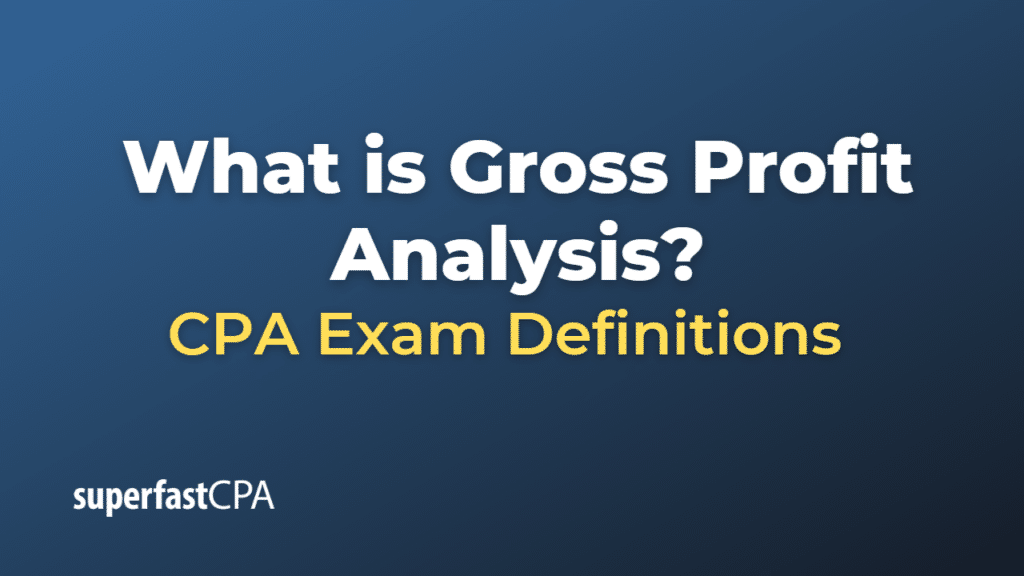Gross Profit Analysis
Gross profit analysis is the examination of a company’s gross profit to assess its financial health and operational efficiency. It’s a crucial part of financial statement analysis and plays a significant role in management, investment, and credit decision making.
The process typically involves comparing gross profit over different periods to identify trends or changes and analyzing the gross profit margin – the percentage of total revenue that exceeds the cost of goods sold (COGS).
Here’s what might be considered in a gross profit analysis:
- Trends and Comparisons: Analysts may examine how gross profit has changed over time and how it compares to other companies in the same industry. Increases in gross profit could suggest higher sales, increased pricing power, or cost efficiencies in production. Declines might indicate falling sales, pricing pressure, or rising production costs.
- Gross Profit Margin: This is gross profit expressed as a percentage of revenue. It provides insights into the company’s production efficiency and pricing strategy. A higher margin could mean the company has a competitive advantage, while a lower one might suggest inefficiency or strong competition.
- Components of Gross Profit: Analysts often examine the components of gross profit – namely, revenue and cost of goods sold. This could reveal insights such as whether changes in gross profit are due to changes in sales volumes, selling prices, direct materials cost, direct labor cost, or manufacturing overhead.
Remember, gross profit analysis should be combined with the analysis of other financial measures and information to provide a complete picture of a company’s performance and financial health.
Example of Gross Profit Analysis
Suppose we have Company A, which manufactures and sells electronics. Company A has reported the following financial data over three years:
- Year 1: Total Revenue: $1,000,000 | COGS: $600,000 | Gross Profit: $400,000
- Year 2: Total Revenue: $1,200,000 | COGS: $650,000 | Gross Profit: $550,000
- Year 3: Total Revenue: $1,400,000 | COGS: $700,000 | Gross Profit: $700,000
We can start our analysis by examining the gross profit margins for each year:
- Year 1: Gross Profit Margin = ($400,000 / $1,000,000) * 100% = 40%
- Year 2: Gross Profit Margin = ($550,000 / $1,200,000) * 100% = 45.8%
- Year 3: Gross Profit Margin = ($700,000 / $1,400,000) * 100% = 50%
Over these three years, Company A’s gross profit margin has been increasing. This suggests that the company has been becoming more efficient in its production, is controlling its costs effectively, or is increasing its prices.
Next, let’s compare the year-over-year growth in revenue and COGS:
- Year 2 vs. Year 1: Revenue Growth = (1,200,000 – 1,000,000) / 1,000,000 * 100% = 20%. COGS Growth = (650,000 – 600,000) / 600,000 * 100% = 8.33%.
- Year 3 vs. Year 2: Revenue Growth = (1,400,000 – 1,200,000) / 1,200,000 * 100% = 16.67%. COGS Growth = (700,000 – 650,000) / 650,000 * 100% = 7.69%.
This analysis shows that Company A’s revenue has been growing at a faster rate than its COGS. This could suggest that Company A is achieving economies of scale or effectively controlling its cost of production, which is contributing to the increase in the gross profit margin.
Lastly, we might compare Company A’s gross profit margins to industry averages or to specific competitors to see how Company A’s operational efficiency compares.
This type of analysis can provide valuable insights into Company A’s operational efficiency, pricing strategy, and overall financial health. However, it would be crucial to combine this with further analysis of Company A’s operating expenses, net income, and other financial metrics to get a complete understanding of the company’s performance.













